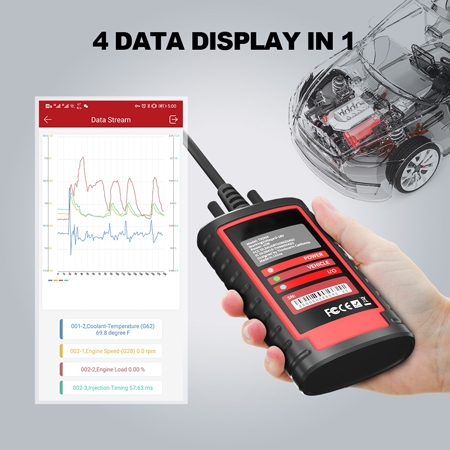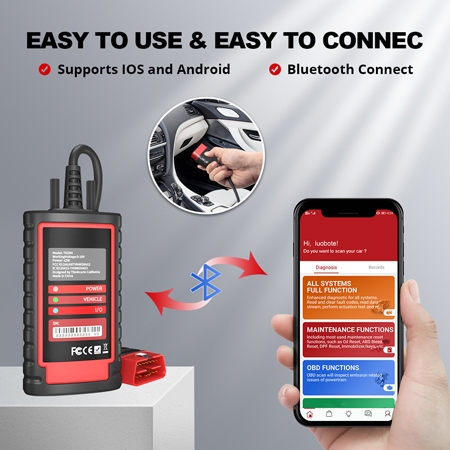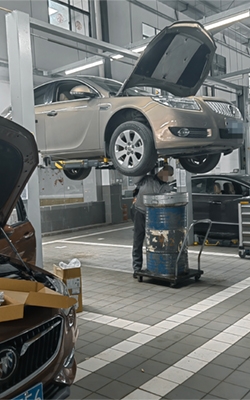Lower cost OBD2 car diagnostic scanner is equipped with multi-functions of CAN-FD protocol, bi-Directional control(Active Test), ECU coding, 15 maintenance resets, all Systems diagnosis, Auto VIN, FCA AutoAuth. This OBDII code scanner is designed for individual car owners, DIYers, and small repair shops.

4 Data Display in 1
- The OBD2 code reader supports 4 data streams displayed simultaneously, enabling efficient real-time comparison and diagnostics.
- View engine speed, coolant temperature, fuel system status, and more-at a glance.
- SISCO car diagnostic code reader helps identify intermittent issues quickly by monitoring multiple parameters side-by-side.
- Customizable data list allows technicians to focus on the most relevant information.
- Ideal for professional-level diagnostics with intuitive multi-graph visualization.

Easy to Use and Connect
- Plug-and-Play Bluetooth Connection: The automotive diagnostic code reader is easily connects to your smartphone or tablet via Bluetooth without complicated setup.
- User-Friendly App Interface: Intuitive mobile app with guided diagnostics and simple navigation.
- Wide Vehicle Compatibility: Supports most OBD2-compliant vehicles with automatic VIN recognition for fast connection.
- Quick Start Function: Device powers up and connects quickly, so you can begin diagnostics in seconds.
Application
SISCO automotive code reader apps are primarily used in the automotive repair industry to help technicians diagnose issues in systems like engines and transmissions. These tools are also widely used in fleet management, vehicle manufacturing, insurance, emissions testing, and automotive education. They not only enhance repair efficiency and reduce repair costs but also provide consumers and fleet managers with real-time vehicle health monitoring, helping to extend vehicle lifespan and optimize operational costs.

Car Repair and Maintenance

Insurance Industry

Emissions Testing

Vehicle Manufacturing
| Model | SISCO-CR-diag2 |
| Support System | Android & lOS |
| Bluetooth | Hardware supports 5.0BLE, Bluetooth dual mode |
| Diagnostic Interface | DB15 |
| Working Voltage | 12V |
| Working Temperature: | -10℃~50℃ |
| Storage Environment | -20~60℃ |
| Shell Material | ABS+PC+TPU rubber sleeve |
| Length of OBD Cable | 0.65m |
| Size | 120.5*65*29mm |
| Weight | 500g |
Q1: What is a code reader?
A1: A code reader is a device used to quickly retrieve and display data encoded in specific formats. In the automotive field, it typically refers to a tool that connects to a vehicle's OBD-II port to read diagnostic trouble codes, helping identify issues related to the engine or emissions system. In retail or logistics, a code reader may refer to a scanner that reads barcodes and QR codes for inventory, checkout, or tracking purposes.
Q2: Does a car have to be running to use a code reader?
A2: No, a car does not have to be running to use a code reader, but the ignition usually needs to be in the "ON" position (engine off, but electronics on). This powers the vehicle's onboard computer system, allowing the code reader to communicate with it and retrieve diagnostic trouble codes. Some functions, however—like real-time data—may require the engine to be running.
Q3: What's the difference between a code reader and a scan tool?
A3: A code reader and a scan tool are both used to diagnose issues in vehicles, but they differ in functionality:
- A code reader is a basic device that reads and clears diagnostic trouble codes (DTCs) and may turn off the check engine light. It's useful for simple diagnostics.
- A scan tool is more advanced. In addition to reading and clearing codes, it can show live sensor data, run system tests, access vehicle information, and sometimes even program modules.
In short, all code readers are scan tools, but not all scan tools are basic code readers-scan tools offer much more detailed and professional-level diagnostics.
Tips: Does the OBD2 car diagnostic scanner support all system diagnostics?
Yes, the car diagnostic code reader supports full system diagnostics, making it a powerful tool for both professionals and car enthusiasts. It is capable of accessing and scanning all available electronic control systems in most OBD2-compliant vehicles, including the engine, transmission, ABS, SRS (airbag), BCM, HVAC, TPMS, and more. This means users can perform comprehensive diagnostics across the entire vehicle, read and clear trouble codes, view live data, and retrieve ECU information. With its broad compatibility and in-depth diagnostic capabilities, the automotive diagnostic scanner helps identify and resolve issues more efficiently, ensuring optimal vehicle performance and safety.
Thank you for buying industrial test and measurement equipment on SISCO.com, all products sold by SISCO and the partner cover a 12 months warranty, effective from the date of receiving the products.
What is covered?
SISCO is responsible for providing free spare parts, and free technical support to assist the customer to repair the defective products until the problem is solved.
What is not covered?
- Product purchased from anyone other than a SISCO store or a SISCO authorized reseller.
- Expendable parts.
- Routine cleaning or normal cosmetic and mechanical wear.
- Damage from misuse, abuse or neglect.
- Damage from use of parts other than SISCO approved.
- Damage from use outside the product’s usage or storage parameters.
- Damage from use of parts not sold by SISCO.
- Damage from modification or incorporation into other products.
- Damage from repair or replacement of warranted parts by a service provider other than a SISCO authorized service provider.
- Damage caused by the application environment not meeting the product usage requirements and the failure to perform preventive maintenance.

